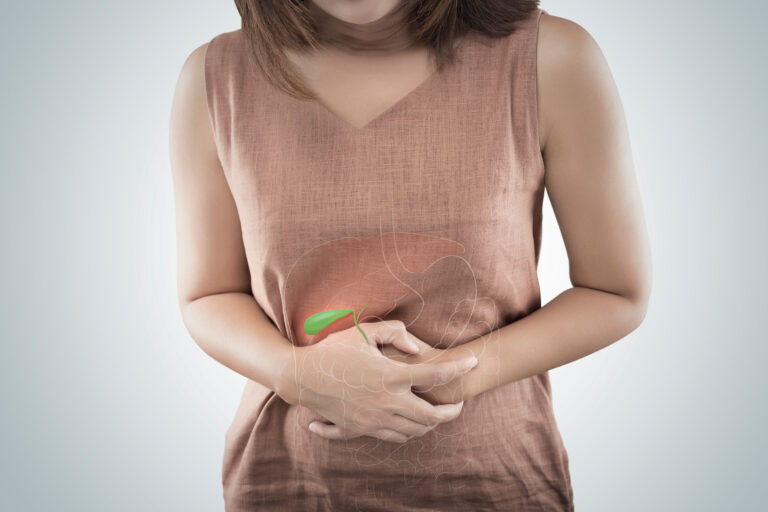Gallbladder

Gallbladder and Gallstones: Causes, Symptoms, Diagnosis, and Treatment
Gallstones are solid deposits that form in the gallbladder due to imbalances in bile composition. They can range in size from as small as a grain of sand to several centimetres. While some people experience no symptoms, gallstones can cause significant discomfort and complications if left untreated. Understanding their causes, symptoms, and treatment options is crucial for managing this condition effectively.
What Are Gallstones and How Do They Form in the Gallbladder?
Gallstones are hardened substances that develop when cholesterol and bile salts crystallise in the gallbladder. The gallbladder, a small organ beneath the liver, stores and releases bile to aid in digestion. When the balance of bile components is disrupted, gallstones can form.
Types of Gallstones and Causes
1. Cholesterol Stones
- The most common type, accounting for approximately 80% of gallstones.
- Composed primarily of cholesterol and bile salts.
- Typically yellow-green in colour.
- Form due to excess cholesterol, insufficient bile salts, or poor gallbladder emptying.
2. Pigment Stones
- Dark brown or black stones composed of bilirubin.
- Often linked to biliary infections, and blood disorders (e.g., sickle cell anaemia).
- More common in individuals with chronic haemolytic conditions.
3. Mixed Stones
- A combination of cholesterol, calcium salts, and bile pigments.
- These stones are more common than pure cholesterol or pigment stones.
Risk Factors for Gallstones
- Gender – Women between the ages of 20 and 60 are more likely to develop gallstones due to hormonal influences.
- Obesity – Increased body weight, raises cholesterol levels in bile, increasing the chance of forming gallstones.
- Hormonal Factors – High oestrogen levels from pregnancy, birth control pills, or hormone replacement therapy increase risk.
- Diabetes – High triglyceride levels associated with diabetes contribute to gallstone formation.
- Rapid Weight Loss – Quick fat metabolism increases cholesterol secretion into bile, promoting gallstone development.
- Diet and Lifestyle – A high-fat, low-fibre diet can increase the risk of gallstones.
Symptoms of Gallstones
While many people with gallstones remain asymptomatic, symptoms can develop when stones obstruct the bile ducts. Common symptoms include:
- Abdominal bloating and discomfort
- Intolerance to fatty foods
- Pain in the upper right abdomen (lasting from 30 minutes to several hours after meals)
- Pain between the shoulder blades or under the right shoulder
- Nausea and vomiting
- Indigestion
These symptoms often mimic other digestive disorders, making accurate diagnosis essential.
How Are Gallstones Diagnosed?
Accurate diagnosis is critical in determining the best course of treatment. Diagnostic methods include:
- Ultrasound: The gold standard for detecting gallstones. A non-invasive imaging test that provides a clear view of the gallbladder.
- CT Scan: Used to detect gallstones and assess complications such as inflammation or bile duct obstruction.
- ERCP (Endoscopic Retrograde Cholangiopancreatography): A specialised endoscopic procedure that identifies and removes gallstones from the bile ducts.
- Blood Tests: Can help detect infection, liver dysfunction, or inflammation caused by gallstones.
Complications of gallstones
If left untreated, gallstones can lead to serious complications, including:
- Biliary Colic – Blockage of the bile ducts causing intense, intermittent pain
- Cholecystitis – Inflammation of the gallbladder, leading to infection and severe, prolonged pain.
- Cholangitis – Infection of the bile duct, requiring urgent medical intervention.
- Pancreatitis – Inflammation of the pancreas due to blocked bile flow.
Early detection and treatment are key to avoiding these complications.
Treatment Options for Gallstones and Gallbladder problems
The best treatment for symptomatic gallstones is surgical removal of the gallbladder, known as cholecystectomy.
1. Laparoscopic Cholecystectomy (Minimally Invasive Gallbladder Removal)
- The most common surgical approach.
- Involves small incisions, a tiny camera (laparoscope), and specialised instruments.
- Offers a faster recovery, less post-operative pain, and minimal scarring.
2. Open Cholecystectomy (Traditional Surgery)
- Only performed for severe cases or complications.
- Involves a larger incision and a longer recovery period.
When to Seek Help
You should seek medical attention if you experience:
✔️ Severe abdominal pain that lasts for hours
✔️ Fever and chills
✔️ Jaundice (yellowing of the skin and eyes)
✔️ Persistent nausea or vomiting
Early treatment reduces the risk of complications and ensures better surgical outcomes.
Schedule a Consultation with Dr. Goutham
Dr. Goutham specialises in advanced gallbladder surgery and offers comprehensive evaluations for gallstone management. If you’re experiencing symptoms, schedule an appointment today to discuss your treatment options and regain your digestive health.

